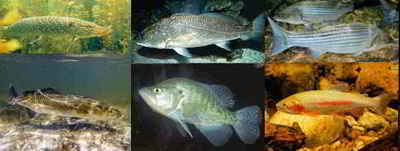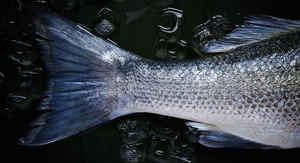
North Carolina Symbols
North Carolina State Saltwater Fish
Channel Bass (Red Drum)
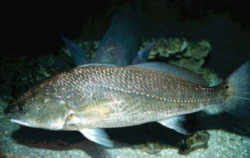
(Sciaenops ocellatus)
Adopted on April 30, 1971 .
Channel Bass, (Sciaenops ocellatus,) usually occur in great supply along the Tar Heel coastal waters and have been found to weigh up to 75 pounds although most large ones average between 30 and 40 pounds.
The General Assembly of 1971 designated the Channel Bass (Red Drum) as the official State Salt Water Fish of North Carolina. (Session Laws, 1971, c. 274; G.S. 145-6).
The red drum (Sciaenops ocellatus), also know as channel bass, redfish or just red, is a game fish that is found from Massachusetts down to Florida and from Florida to Northern Mexico. Scientific classification or biological classification is how biologists group and categorize extinct and living species of organisms.
North Carolina State Salt Water
Fish:
Channel Bass (Red Drum)
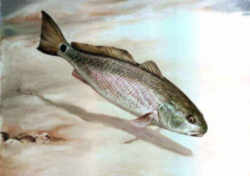
The red drum (Sciaenops ocellatus), also known as channel bass, redfish, spottail bass or simply reds, is a game fish that is found in the Atlantic Ocean from Massachusetts to Florida and in the Gulf of Mexico from Florida to Northern Mexico. It is the only species in the genus Sciaenops. The red drum is a cousin to the black drum (Pogonias cromis), and the two species are often found in close proximity to each other; they can interbreed and form a robust hybrid, and younger fish are often indistinguishable in flavor.
Other Names
Redfish, Rat Red, Bull Red, Or Just \"red\"
Characteristics of the Channel Bass (Red Drum)
The most distinguishing mark on the red drum is one large black spot on the upper part of the tail base. Having multiple spots is not uncommon for this fish but having no spots is extremely rare. The color of red drum ranges from a deep blackish, coppery color to nearly silver. The most common color is reddish-bronze. Red drum is a fast growing fish reaching approximately 11 inches and one pound in its first year, 17-22 inches and 3 1/2 pounds in two years, and 22-24 inches and 6-8 pounds in three years. The record red drum was 94 pounds and was caught on the East coast.
Life History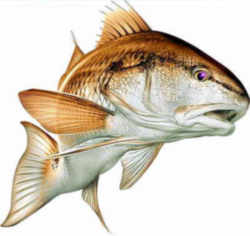
For the first three years of their lives red drum live in the bays or in the surf zone near passes. Evidence from tag returns show that they remain
in the same area and generally move less than 3 miles from where they were tagged. As they mature, they move from the bays to the Gulf of Mexico where
they remain the rest of their lives, except for infrequent visits to the bays. Although there is little evidence of seasonal migrations, anglers find
concentrations of red drum in rivers and tidal creeks during the winter. Daily movement from the shallows to deeper waters is influenced by tides and
water temperatures. During the fall, especially during stormy weather, large adult red drum move to the gulf beaches, possibly for spawning, where
they can be caught from piers and by surf anglers. This is known as the \"bull redfish run.\"
Young red drum feed on small crabs, shrimp, and marine worms. As they grow older, they feed on larger crabs, shrimp, small fish, and sometimes their
cousins, the Atlantic croaker. They generally are bottom feeders but will feed in the water column when the opportunity arises. A phenomenon called
\"tailing\" occurs when the red drum feed in shallow water with their head down in the grass and the tail exposed to the air. Predators include humans,
birds, larger fish, and turtles.
Between the third and fourth year, the red drum reaches sexual maturity. Spawning season is from mid-August through mid-October in Gulf waters, near
the mouths of passes and shorelines. Eggs incubate for 24 hours. Larvae are carried into tidal bays by the current. They move to quiet, shallow water
with grassy or muddy bottoms to feed on detritus (dead or decomposing plant and animal matter). The oldest recorded red drum was 37 years old!
During spawning, red drum males attract females by producing a drum-like noise by vibrating a muscle in their swim bladder. They sometimes swim in
water so shallow that their backs are exposed.
Red drum are related to black drum, spotted seatrout, weakfish, mullets and croakers, most of which also make drumming sounds. Scientists believe that
the black spot near their tail helps fool predators into attacking the red drum\'s tail instead of their head, allowing the red drum to escape.
North Carolina Law
The law designating the channel bass (red drum) as the official North Carolina State saltwater fish is Section 145-6 (State saltwater fish ) of the North Carolina General Statutes Chapter 145 (State Symbols and Other Official Adoptions) Section 145-6
Chapter 145: State Symbols and Other Official Adoptions.
SECTION 145-6.
? 145-6. State saltwater fish.
The channel bass (red drum) is hereby adopted as the official State saltwater fish of the State of North Carolina. (1971, c. 274.)
Taxonomic Hierarchy: Channel Bass (Red Drum)
Kingdom: Animalia - animals
Phylum: Chordata - chordates
Subphylum: Vertebrata - vertebrates
Superclass: Actinopterygii - ray-finned fishes
Class: Perciformes - perch-like fishes
Order: Sciaenidae - coakers, corbs, courbines,
croakers, drums, maigres, ombrines, roncadores
Family: Sciaenops:
Genus: Sciaenops
Species: Sciaenops ocellatus
